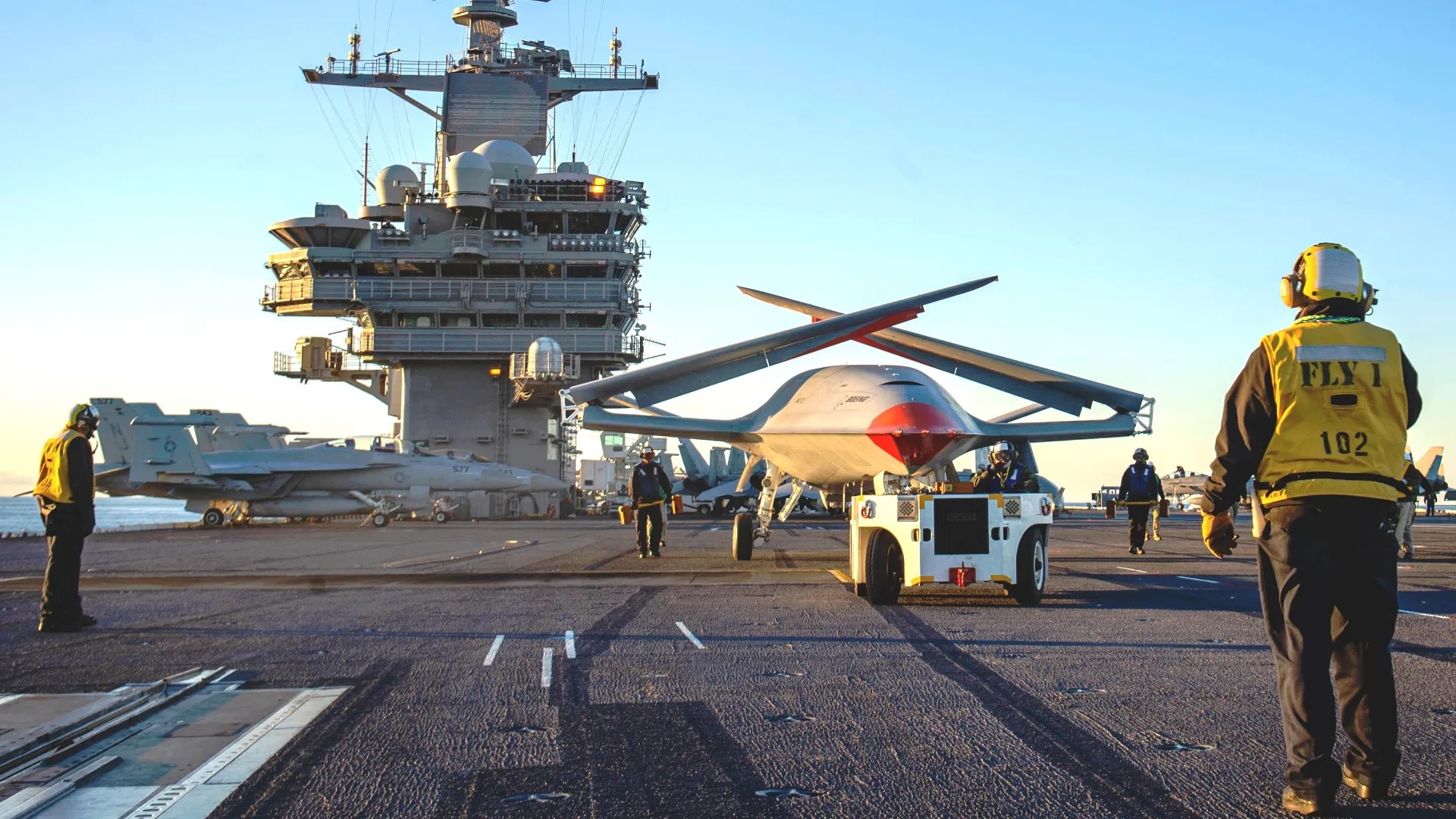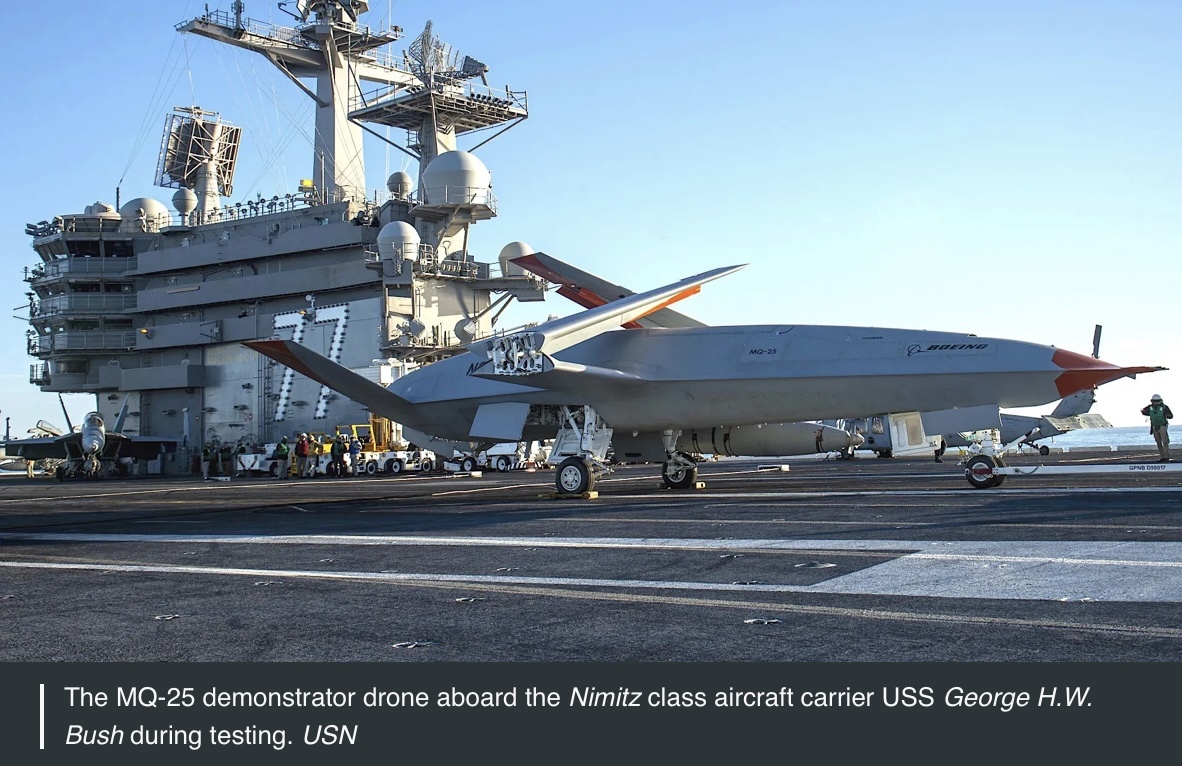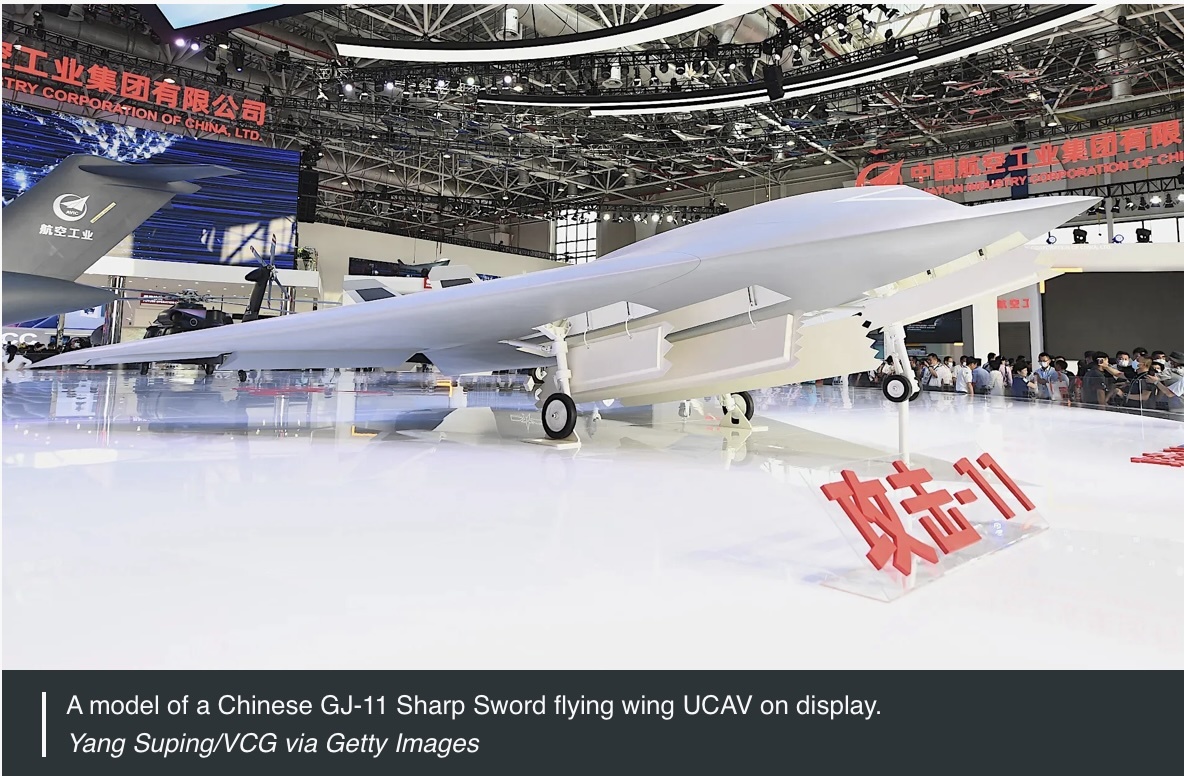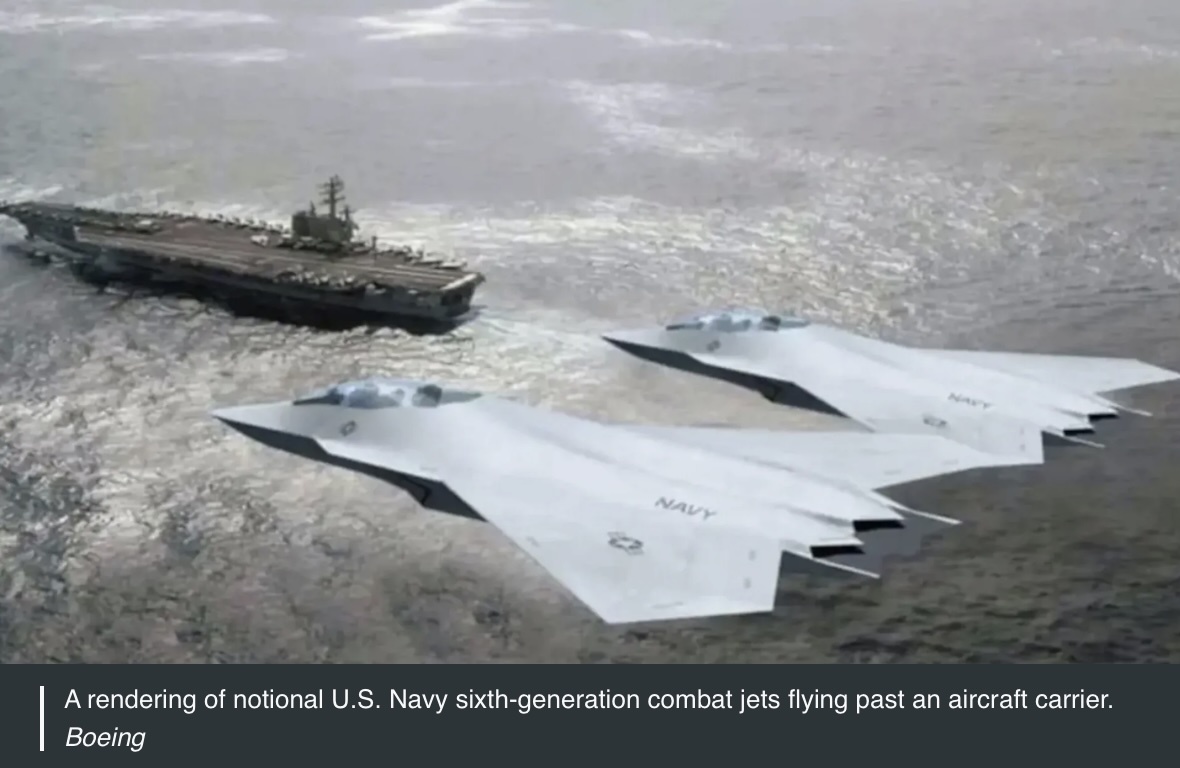8.02.2025
MQ-25 tanker drones, longer-range weapons, new advanced aircraft, and better networks are central to the Navy's carrier airpower vision.

U.S. Navy officials have laid out several priorities they say are key to ensuring the service’s carrier air wings will be able to succeed in future conflicts, especially a high-end fight in the Pacific. The MQ-25 Stingray tanker drone, which will help provide critical range extension and persistence for other aircraft, is the centerpiece of those efforts. New long-range weapons, advanced platforms that can penetrate deep into dense enemy air defense environments, and robust networks to support the kill chains that underpin all of this are also essential to the Navy’s current carrier-based airpower vision.
Navy officers talked about the service’s carrier fleets and their air wings during a panel discussion, which TWZ attended, earlier today at the WEST 2025 conference.
“MQ-25, plus long-range weapons and kill chains, plus a robust command and control, and platforms that can gain access to contested environments, are the vision and the key to the future of the carrier air wing to be able to operate out in the Pacific,” Capt. Lew Callaway, head of the Strike Aircraft and Weapons Branch within the Office of the Chief of Naval Operations’ Air Warfare Division, said. “I want to pivot to the MQ-25 because it’s the nearest, most important capability that we’re going to field in order to extend the range and the persistence of the carrier air wing.”
Extending the reach of other aircraft in carrier air wing, as well as eliminating the need to use crewed F/A-18F Super Hornets in the tanker role, are the stated primary missions for the MQ-25. The Stingrays will also have a secondary intelligence, surveillance, and reconnaissance (ISR) capability. Though not mentioned explicitly during today’s panel at WEST 2025 there has also been talk about using the MQ-25, or future variants thereof, as a carrier-based standoff strike platform.
Range and persistence have long been important considerations for carrier aviation operations, but are increasingly more so as threat air defense ecosystems grow. In addition to the growing risks they present to carrier-based aircraft, work by potential adversaries like China to expand their air defenses, as well as long-range strike capabilities, could easily limit access to land-based tankers that Navy carrier air wings, especially their shorter-legged tactical jets, often rely on today. The availability of bases on the ground, or lack thereof, could put further constraints on traditional aerial refueling support, especially during operations across the broad expanses of the Pacific.
Last year, the Navy notably put out a contracting notice expressing interest in options for extending the unrefueled range of its F/A-18E/F Super Hornet fighters and EA-18G Growler electronic warfare jets. In recent years, the service has also been fielding E-2D Hawkeye airborne early warning and control aircraft with new inflight refueling capability.
The MQ-25 program has been beset by delays and cost growth for years now. Navy Vice Adm. Daniel Cheever, the Navy’s top aviation officer, said separately at WEST 2025 that the service expects the first production representative Stingray to make its maiden flight before the end of this year and to fly from the deck of an actual carrier in 2026, according to Breaking Defense.
Various ground and flight testing has already occurred using a demonstrator drone and the Navy has been otherwise working to lay the groundwork for the Stingray’s arrival. This includes the integration of new dedicated uncrewed aviation control centers on its carriers, which the service has made clear will be able to support additional pilotless platforms in the future.
“One of the primary goals of MQ-25 is just going to be, for the first time, to integrate unmanned aviation into the air plan, into the day-to-day [operational tempo], so it just becomes second nature,” Capt. Callaway said today. “And we’re going to take a sequential mindset when it comes to follow-on unmanned vehicles.”
“MQ-25 is absolutely the Navy’s push to make sure that we have demonstrated you can take an unmanned platform and put it on a carrier, but demonstration is way different than operating every single day,” Rear Adm. Keith Hash, head of the Naval Air Warfare Center’s Weapons Division and another one of the panelists, added. “I think we’re positioning ourselves so when MQ 25 starts flying this year, gets ready to go to the carrier in the near future, you know, we will make that robust. And when other options come along … [we] will be ready to accelerate those into the carrier environment [and] into other environments.”

The Navy has a long-standing goal for its air wings to be up to 60 percent uncrewed in the future. Last year, the service also outlined a vision for a future fleet of lower-cost carrier-capable drones that might even be cheap enough to be optionally expendable, as you can read more about here. In addition, the Navy and the Air Force have a formal agreement to develop common architectures that will allow for the seamless exchange of control of uncrewed platforms between the services during future operations.
Work on advanced uncrewed carrier-based aviation capabilities has exploded globally in recent years, as has potential interest in doing so. China is notably pursuing at least one stealthy flying wing-type uncrewed combat air vehicle (UCAV), the GJ-11 Sharp Sword, variants or derivatives of which look increasingly set to fly from at least some of the country’s carriers, as well as its new super-sized Type 076 amphibious assault ship. The U.S. military has no known analog to the GJ-11, land or carrier-based, having abandoned similar efforts, including the Unmanned Carrier-Launched Airborne Surveillance and Strike (UCLASS) program that preceded the MQ-25, around a decade ago. The United Kingdom, Turkey, and others are also actively pursuing different tiers of carrier-based drones.

For the U.S. Navy, as Capt. Callaway noted, drones are only one part of a larger vision for the future of the service’s carrier air wings.
“Long range weapons are probably [coming] right after the MQ-25 in time frame,” Callaway said. That is a “capability that gets us access anywhere we want, whether it be in the [Indo-]Pacific Command’s AOR [area of responsibility] … [or] wherever we need to put ordnance on target.”
Callaway did not elaborate on the munitions or types of munitions in question. Last year, the Navy did formally unveil an air-launched version of its ship-launched multi-purpose SM-6 called the AIM-174B. The service has also said the missile is in at least limited service now with its Super Hornets being the current launch platform. TWZ has previously laid out in detail how the AIM-174B will be an especially key part of countering still expanding Chinese anti-access and area denial capabilities.
The Navy is also looking to field air-launched air-breathing hypersonic anti-ship cruise missiles no later than 2029. Future versions of the missile being developed under the Hypersonic Air-Launched Offensive Anti-Surface Warfare (HALO) program could arm the service’s ships and submarines. There is the potential for it to be adapted for use against targets on land, as well.
The AGM-88G Advanced Anti-Radiation Guided Missile-Extended(AARGM-ER) and the AGM-158C-3 version of the Long-Range Anti-Ship Missile (LRASM) are also set to join the Navy’s air-launched arsenal in the coming years. Additional work is ongoing in the classified realm, as well.
In terms of penetrating platforms for future carrier air wings, the Navy is pushing ahead with plans for a new sixth-generation crewed stealth combat jet, referred to currently as F/A-XX. The service said last October that it was getting close to picking a winning F/A-XX design and the hope is that the first examples will begin entering service in the 2030s.

F/A-XX is set to replace the F/A-18E/F and the EA-18G, but both of those existing aircraft are currently expected to continue serving into the 2040s. F-35C Joint Strike Fighters, E-2 Hawkeyes, CMV-22 Osprey tilt-rotors, and MH-60 Seahawk helicopters are also set to remain parts of the Navy’s carrier air wings for years to come.
As the carrier air wing’s reach and other capabilities grow, the need for new and improved networking capabilities will only increase. This is something TWZ has explored in-depth in the past.
“We really need to be clear and understanding of the communications and the command and control and the enablers of that long-range kill chain that happens both after you go down the [catapult] shuttle [to launch off the carrier to] after you pull the trigger,” Capt. Callaway said.
“We are adjusting and learning and growing and turning inside the circle of those who might bring harm to our folks and to our commerce and lines of communication, and so we’re working diligently on setting up our own long-range fires, kill chains, making them robust,” Rear Adm. Hash added. In addition, “can’t get into the details, as you can imagine … but there’s activity along the way to make sure that we can operate in a contested electronic warfare environment, that we have got use of that spectrum, and that we can prevent that spectrum from impacting us, giving us opportunity to surge in and surge out.”
Altogether, the Navy’s future carrier air wing plans continue to coalesce a vision that has longer reach and greater persistence and that is more uncrewed, lethal, and interconnected than ever before.
Quelle: The Warzone
